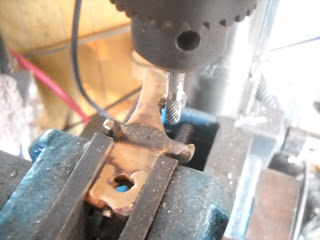New 4943 aluminum better than 4043. pdf?
When should I use 4043 or 5356 ?
Miller tig handbook pdf.
Aluminum alloy Filler Chart.
aluminum fill wire chemistry (typical) pdf
300 series stainless (word document)
flux coated stainless filler pdf
Basic filler metal tech (ESAB) pdf
INCONEL filler metal 601
BOHLER welding guide pdf
Phoenix union thermanit pdf (huge)
Aluminum
There are approximately 12 designations for aluminum
filler rods. A common all purpose rod is ER4043. The “ER”
designates electrode or rod, and the “4043” designates a
specific chemical composition. ER4043 is used with many
aluminum base metals, but always consult electrode wire
manufacturers for the proper filler to use in critical welds.
Filler Metal Specifications:
The American Welding Society (AWS) publishes several
booklets of specifications for GTAW filler materials. Often
these booklets are used as specifications for GMAW electrode
wires as well. Figure 4.19 is a list of AWS filler material,
shielding gas and tungsten electrode specification booklets.
Figure 4.19 AWS specifications for GTAW filler materials, shielding gases
and tungsten electrodes.
Types and Designations of
Filler Metals
Steel
There are seven designations for carbon steel filler rods. A
typical designation would be ER70S-6 for TIG. The “ER”
means the filler can be used for either GTAW or GMAW. If the
designation lacked the “R” it would signify a continuous electrode
for use with GMAW only. There is no designation for rod
using just the “R”, it will always be “ER”. The “70” stands for
the welded tensile strength, measured in thousands of
pounds per square inch. “S” stands for “Solid” electrode as
opposed to a tubular or hollow wire such as that used in the
flux cored welding process. And the “6” refers to the particular
degree of manufactured chemical percentages within the rods
composition. In other words, the number at the end of the
description refers to which classification of wire is being used.
Stainless Steels
There are many more stainless steel designations than there
are steel designations. A typical classification of a stainless
rod would be ER308. The “ER”, as it is in steel, stands for either
continuous electrode, or electrode rod. The “308” designates
a specific stainless steel chemical composition. These numbers
are often used to match the filler rod to specific compositions
of base metals being welded.
Certain types of stainless steel rods may have letters or numbers
after the three digits, such as “L” meaning low carbon
content, or “Si” meaning high silicon content. Sometimes a
manufacturer’s brand name may use “ELC” instead of “L” to
mean Extra Low Carbon, or “HiSil” instead of “Si” meaning
High Silicon Content.
It’s important to remember the “ER” designations because
the AWS has separate specification books for “ER” filler metals
and for “E” filler metals. “E” filler metals, such as E308-16,
would refer to covered welding electrodes, such as those
used for SMAW (Stick).
Titanium
There are approximately 13 different designations for titanium
filler rods. A typical designation would be ERTi-5ELI. The
“ER” means the filler can be used for either GTAW or GMAW.
The “Ti” indicates titanium, the “5” is specific characteristics
such as alloy content, and the “ELI” means extra-low interstitial
impurities. If the base metal has extra-low interstitial impurities
the filler metal selected should also carry the same classification. The interstitial nature of elements such as carbon,
hydrogen, oxygen and nitrogen are kept very low with the
ELI classification.
When welding titanium and its alloy, the filler metal should
closely match the alloy content of the base metal being welded.
The ERTi-1, -2, -3 and -4 are designations for commercially
pure titanium (CP) welding. These unalloyed filler metals can
tolerate some contamination from the welding atmosphere
without significant loss in ductility. Unalloyed filler metals
may be used to weld titanium alloys when ductility is more
important than joint strength. Less than 100% joint efficiencies
can be expected.
A5.7 Copper and Copper Alloy
Bare Welding Rods and
Electrodes
A5.9 Corrosion Resisting
Chromium and
Chromium-Nickel Steel
Bare and Composite
Metal Cored and Stranded
Welding Electrodes and
Welding Rods
A5.10 Bare Aluminum and
Aluminum Alloy Welding
Electrodes and Rods
A5.12 Tungsten and Tungsten
Alloy Electrodes for Arc
Welding and Cutting
A5.13 Solid Surfacing Welding
Rods and Electrodes
A5.14 Nickel and Nickel Alloy
Bare Welding Rods and
Electrodes
A5.16 Titanium and Titanium
Alloy Welding Electrodes
and Rods
A5.18 Carbon Steel Filler Metals
for Gas Shielded Arc
Welding
A5.19 Magnesium Alloy
Welding Rods and Bare
Electrodes
A5.21 Composite Surfacing
Welding Rods and
Electrodes
A5.24 Zirconium and Zirconium
Alloy Bare Welding Rods
and Electrodes
A5.28 Low Alloy Steel Filler
Metals for Gas Shielded
Arc Welding
A5.30 Consumable Inserts
A5.32 Welding Shielding Gases
Typical Sizes of Flattened Rods*
Thickness
Equivalent Round
Diameter Width
in. mm in. mm in. mm
1/16 1.6
3/32 2.4
1/8 3.2
5/32 4.0
3/16 4.8
1/4 6.4
1.2
1.8
2.4
2.9
3.6
4.8
0.047
0.070
0.095
0.115
0.140
0.187
1.8
2.7
3.6
4.4
5.3
7.1
0.072
0.105
0.142
0.175
0.210
0.280
*Standard length shall be 36 in. +0, –1/2 in. (approximately 900 ±20 mm).
41
for GTAW • Gas Tungsten Arc Welding


















































